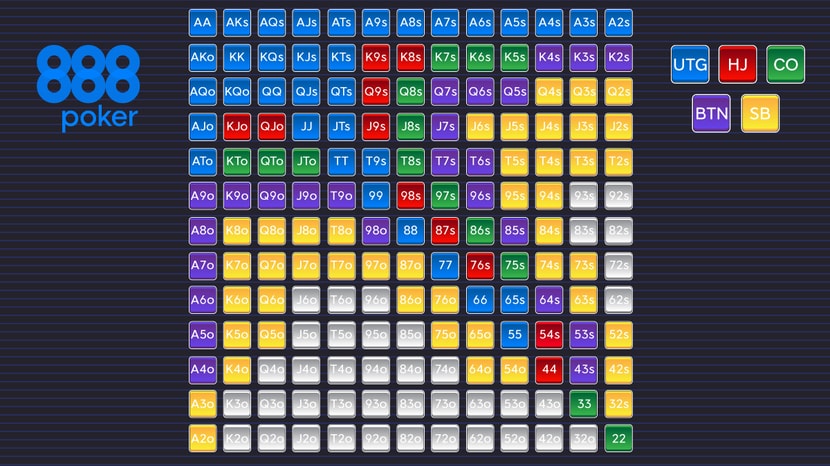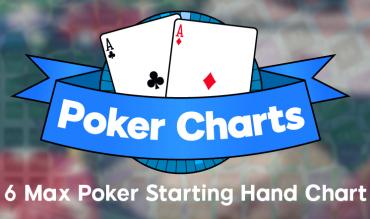In poker, being in position during a poker hand (last to act on each post-flop betting round) is going to give you a massive advantage. Seeing how your opponents act first will allow you to play more optimally against them in addition to being able to put them in tight spots often and profit more from them.
To compensate for potentially being out-of-position in a hand, in the preflop betting round, the further you are to the right of the button (being one of the first players to act), the tighter your starting hand range should be for when you come in for an open-raise.
This is not only because you may be out-of-position for the rest of the hand, but you may also get 3bet from an in-position player too. If you open too wide, you run into the problem of having to defend your range too wide appropriately, as well, (based on minimum defense frequency - MDF). You’ll likely have to continue with hands that are actually slightly –EV to be raising/calling.
Table of Contents
Poker Starting Hand Chart (6-Max Cash, 100bb)
As such, it’s essential only to raise hands that are going to be +EV to start with (for an open-raise).
And thanks to the help of poker solver like PokerSnowie and PioSolver, we can create a baseline for our 6-Max poker starting hand chart.

Note that the range of hands that we can open-raise with gets wider and wider, the closer we are to the button.
Also notice that these are hands that we are *open* raising with, which means that action has folded to us when we are in the corresponding seating position in the hand (no limpers; no straddles; no other raises before us; etc.).
Lastly, it should be noted that the above chart shows the SB open-raising range for raising first in (RFI). If we choose to play GTO, it’s suggested to have a mixed strategy that includes some open-limps and some open-raises from the SB, but for the purposes of this article, we’ve kept it simple with this baseline RFI chart by keeping limps out of the question.
Studying this baseline chart is a necessity for developing a winning strategy in poker. If you’re opening up too many hands, even if it’s slightly –EV to open with preflop, your mistakes throughout the hand are going to compound - potentially putting you in even bigger –EV spots, if you play sub-optimally post-flop.
Also, bear in mind that a recommended 2.5x raise size is recommended for this chart. This strategy, of course, will make it more ideal for online play than live (where rake tends to be higher, and games often play a bit differently than online, especially at lower stakes).
When To Deviate From This Chart
This chart is a GTO poker chart for hands to open-raise within a 6-max game. This fact means that if everyone is playing perfectly, this is the chart to go by.
The thing is, though, in poker, no one is going to play correctly. Everyone is going to have holes and weaknesses in their game. The bigger a player’s leaks and flaws are, the more you should be looking to exploit these leaks, instead of playing a fundamentally sound game yourself, solely to try and maximise your profit.
Here are just a few examples of situations where you may choose to deviate from this baseline chart:
- If you have a fish in the big blind, raise wider, especially as you get closer to the button.
- If you have a LAG 3bettor on your direct left, open-raise tighter.
- If you’re still developing your fundamental strategies for postflop play, raise tighter. (This strategy will eliminate small +EV situations preflop and help give you the larger +EV situations for postflop, as you work to improve.)
- If you have tighter players to your left (more likely to fold preflop to a raise than usual), open-raise wider.
These are just a few examples. You could also experiment with raising larger or smaller with your ENTIRE range based on table dynamics, if you want a tighter or wider hand range, and if you’re trying to achieve a specific result.
A Word on Preflop Raise Sizing
The smaller you open-raise, the more poker hands you can open (by a small percentage).
If you raise larger, then generally you should have a tighter range of hands.
When playing micro stakes, some coaches advocate a 4x UTG open raise. Then reducing to 3x for HJ, 2.5x for CO and BTN, and then back to between 3 and 4x for SB opens.
The reason for these larger-than-normal recommended open-sizes is because the range of hands that will call an open-raise in the micro stakes is much higher than as you move up. (You can get more value from your more-premium-heavy hand ranges from OOP, like UTG and HJ than when you’re opening wider in LP.)
As a very brief example of this, if you have a tight, recommended UTG range, and you have a BTN player who’s going to call both a 3x or 4x-open with Q8s, then you might as well push for that extra value. Your range is going to be stronger than their calling range.
In live play, most players raise to 4-5x the big blind. (Usually only starting at 2/5, you’ll only see select players opening up to 3x.) This play is exploitable, but there is valid reasoning behind it.
Namely, many more players in live play want to see flops (as they’re only playing about 25 hands/hr), so you want to discourage some hands from calling while simultaneously gaining value from worse hands. If by raising larger, you can get more folds preflop to get a pot heads-up, then this is beneficial too. You’ll also retain the highest amount of equity versus ONE other hand, than, say – FIVE other hands – regardless of what your hand is!
Exploitatively, it’s okay to experiment with your open-raise sizing when at a table, too. If you have a loose cannon in the mix, they’ll often have a threshold for how much they’ll willingly see a flop.
Feel free to keep boosting your open-raise sizes (while maintaining an exploitatively tighter range, if that’s the case) until you find what their threshold is.
Acting AFTER an Open-Raise
While this article aims to deal with OPEN-raises, I think it’s crucial to still touch on this point in brief.
In general, if another player opens, you should call with hands that do better than the majority of their opening range, and then 3bet for value with your best hands, and mix in some bluffs with hands that are slightly too poor to call with.
Yes, it’s always important to take a player’s table image, raise size, and stack size into account, but such is the case with all aspects of poker.
You should always take ALL of the different variables into account.
In Conclusion
Be sure to study the chart above and review it frequently until you know it like the back of your hand.
Knowing and understanding GTO charts like this in poker is essential so that you can have a solid baseline, and then be able to deviate from it, as necessary, if the situation calls for it.


